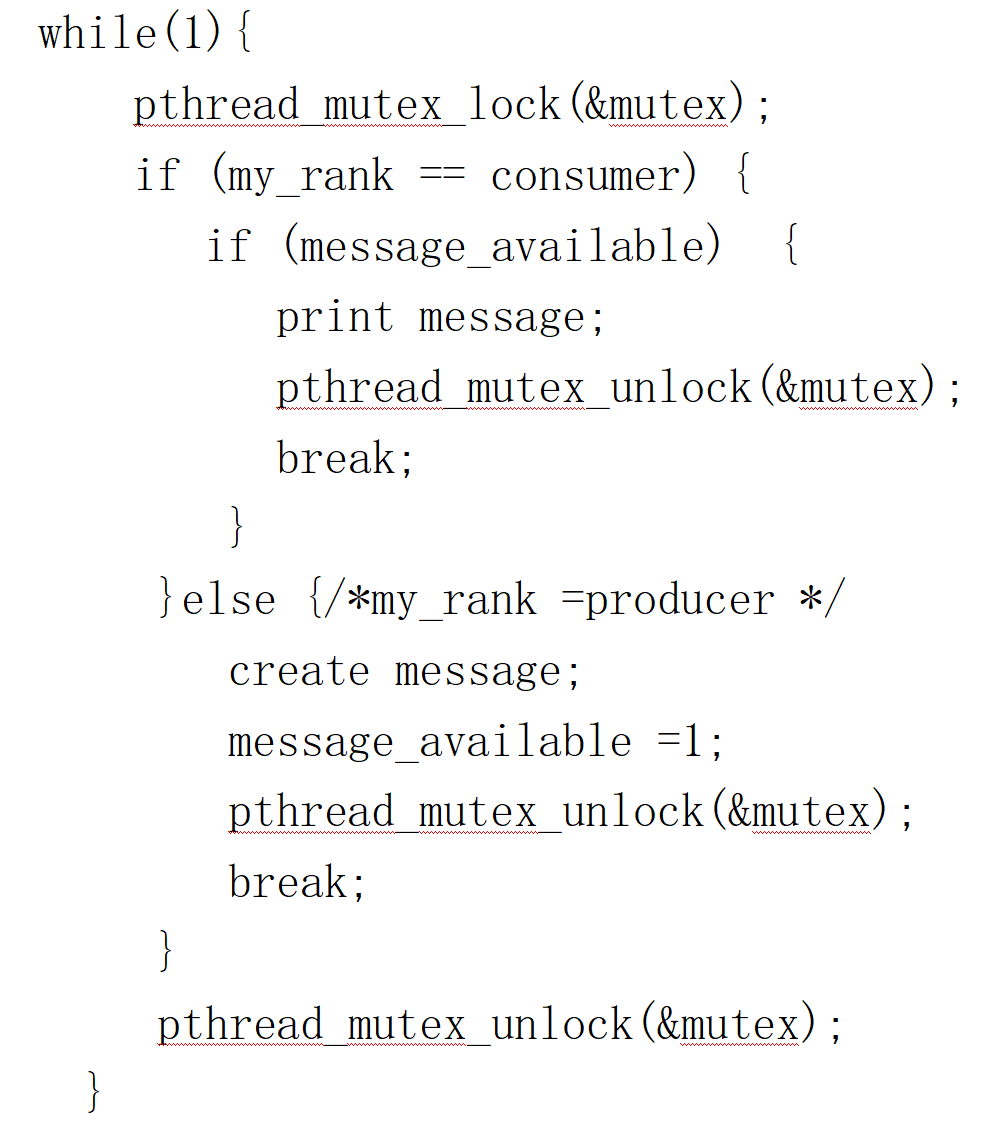4.5 请修改使用互斥量的π计算程序,使临界区在for循环内。这个版本的性能与原来的忙等待版本相比如何?我们怎样解释它? 首先查询$\pi$的计算公式
思路相对简单,用多个线程处理计算,并将所有的计算都累加,最后得出$\pi$的值.
忙等待 1 2 3 4 5 6 7 8 9 10 11 12 13 14 15 16 17 18 19 20 21 22 23 24 25 26 27 28 29 30 31 32 33 34 35 36 37 38 39 40 41 42 43 44 45 46 47 48 49 50 51 52 53 54 #include <stdio.h> #include <stdlib.h> #include <pthread.h> int thread_count;double sum = 0.0 ;int flag = 0 ; void *Thread_sum (void * rank) int main (int argc,char * argv[]) long thread; pthread_t * thread_handles; thread_count = strtol (argv[1 ],NULL ,10 ); thread_handles = malloc (thread_count*sizeof (pthread_t )); for (thread = 0 ;thread < thread_count;thread++){ pthread_create (&thread_handles[thread],NULL ,Thread_sum,(void *)thread); } for (thread = 0 ;thread < thread_count;thread++){ pthread_join (thread_handles[thread],NULL ); } free (thread_handles); printf ("%f" ,4 *sum); return 0 ; } void *Thread_sum (void *rank) long my_rank=(long )rank; double factor,my_sum = 0.0 ; long long i; long long my_n = n/thread_count; long long my_first_i = my_n*my_rank; long long my_last_i = my_first_i + my_n; if (my_first_i % 2 == 0 ) factor = 1.0 ; else factor = -1.0 ; for (i = my_first_i;i < my_last_i;i++,factor = -factor){ my_sum += factor/(2 *i+1 ); } while (flag != my_rank); sum += my_sum; flag = (flag+1 ) % thread_count; return NULL ; }
忙等待的方法使用了while循环,持续占用CPU资源,且执行相加的顺序是按照编号的,可行性不足。
互斥量 1 2 3 4 5 6 7 8 9 10 11 12 13 14 15 16 17 18 19 20 21 22 23 24 25 26 27 28 29 30 31 32 33 34 35 36 37 38 39 40 41 42 43 44 45 46 47 48 49 50 51 52 #include <stdio.h> #include <stdlib.h> #include <pthread.h> int thread_count; double sum = 0.0 ;int flag = 0 ; pthread_mutex_t mutex;void *Thread_sum (void * rank) int main (int argc,char * argv[]) long thread; pthread_t * thread_handles; thread_count = strtol (argv[1 ],NULL ,10 ); thread_handles = malloc (thread_count*sizeof (pthread_t )); pthread_mutex_init (&mutex,NULL ); for (thread = 0 ;thread < thread_count;thread++){ pthread_create (&thread_handles[thread],NULL ,Thread_sum,(void *)thread); } for (thread = 0 ;thread < thread_count;thread++){ pthread_join (thread_handles[thread],NULL ); } free (thread_handles); pthread_mutex_destroy (&mutex); printf ("%f" ,4 *sum); } void *Thread_sum (void *rank) long my_rank=(long )rank; double factor,my_sum = 0.0 ; long long i; long long my_n = n/thread_count; long long my_first_i = my_n*my_rank; long long my_last_i = my_first_i + my_n; if (my_first_i % 2 == 0 ) factor = 1.0 ; else factor = -1.0 ; for (i = my_first_i;i < my_last_i;i++,factor = -factor){ my_sum += factor/(2 *i+1 ); } pthread_mutex_lock (&mutex); sum += my_sum; pthread_mutex_unlock (&mutex); return NULL ; }
通过使用枷锁方法pthread_)mutex_lock()和解锁方法pthread_mutex_unlock()实现每次只有一个线程访问临界区,可以解决对关键部分的冲突访问。
4.6 请修改使用互斥量的π计算程序,使用信号量替代互斥量。这个版本的性能与互斥量版本相比如何? 信号量 1 2 3 4 5 6 7 8 9 10 11 12 13 14 15 16 17 18 19 20 21 22 23 24 25 26 27 28 29 30 31 32 33 34 35 36 37 38 39 40 41 42 43 44 45 46 47 48 49 50 51 52 53 #include <stdio.h> #include <stdlib.h> #include <pthread.h> #include <semaphore.h> int thread_count;double sum = 0.0 ;int flag = 0 ; sem_t sem; void *Thread_sum (void * rank) int main (int argc,char * argv[]) long thread; pthread_t * thread_handles; thread_count = strtol (argv[1 ],NULL ,10 ); thread_handles = malloc (thread_count*sizeof (pthread_t )); sem_init (&sem,0 ,1 ); for (thread = 0 ;thread < thread_count;thread++){ pthread_create (&thread_handles[thread],NULL ,Thread_sum,(void *)thread); } for (thread = 0 ;thread < thread_count;thread++){ pthread_join (thread_handles[thread],NULL ); } free (thread_handles); sem_destroy (&sem); printf ("%f" ,4 *sum); } void *Thread_sum (void *rank) long my_rank=(long )rank; double factor,my_sum = 0.0 ; long long i; long long my_n = n/thread_count; long long my_first_i = my_n*my_rank; long long my_last_i = my_first_i + my_n; if (my_first_i % 2 == 0 ) factor = 1.0 ; else factor = -1.0 ; for (i = my_first_i;i < my_last_i;i++,factor = -factor){ my_sum += factor/(2 *i+1 ); } sem_wait (&sem); sum += my_sum; sem_post (&sem); return NULL ; }
初始化设定sem=1,所以在第一个要访问临界区的线程,运行sem_wait(sem),sem减一,并可以访问临界区。而其他线程执行sem_wait(sem)时,因sem=0,所以处于等待的状态。相比于互斥量的实现,信号量可以将信号初始化为一个任意非负值。
4.7 尽管生产者一消费者同步采用信号量很容易实现,但它也能用互斥量来实现。 基本的想法是:让生产者线程和消费者线程共享一个互斥量。用一个被主线程初始化为false的标志变量来表示是否有产品可以被“消费”。这两个线程的执行如下:
如果消费者线程首先进入循环,它会看到没有可用的信息(message_available值为false)并在调用pthread_mutex_unlock后返回。消费者线程重复上述过程,直到生产者线程生产出信息。请编写一个双线程程序,实现这个版本的生产者一消费者同步。可以将这个程序一般化吗?让它能够运行2k个线程,其中奇数线程是消费者,偶数线程是生产者。另外,将程序一般化为每个线程既是生产者又是消费者,能做到吗?例如,线程q既要发送一条信息给线程(q+1) mod t,又要从线程(q-1+t) mod t接收一条信息,如何编写程序?要使用忙等待吗?
解决思路 我们使用队列queue 来表示上述具有n个缓冲区的缓冲池。每投入(取出)一个产品,缓存池中就相应的插入(删除)一个节点。由于该缓冲池是被组织成队列的形式,因此,队空队满的判断条件分别如下:
1 2 q->front == q->rear; q->front == (q->rear+1 )%SIZE;
引入一个整型变量num,置其初值为0,当生产者(消费者)进程向缓冲池投入(取走)一个产品时,num对应的加一(减一)。同时,由于缓冲区是共享的,因此需要对生产者、消费者使用缓冲区进行限制,以此达到同步的效果,即在生产者向缓冲区投入产品时,消费者不得使用缓冲池;消费者向缓冲区取出产品时同理。
生产者和消费者的操作进程可如下表示:
1 2 3 4 5 6 7 8 9 10 11 12 13 14 15 16 17 18 void producer () sem_wait (); lockf (); QueueFull (); Enqueue (); unlockf (); sem_post (); } void customer () sem_wait (); lockf (); QueueEmpty (); Dequeue (); unlockf (); sem_post (); }
双线程 1 2 3 4 5 6 7 8 9 10 11 12 13 14 15 16 17 18 19 20 #define TRUE 1 #define FALSE 0 #define SIZE 2 int main () srand ((unsigned int )time (NULL )); sem_init (&sem.count, 0 , 10 ); pthread_mutex_init (&mutex, NULL ); InitQueue (&(sem.q)); pthread_t producid; pthread_t consumid; pthread_create (&producid, NULL , Producer, NULL ); pthread_create (&consumid, NULL , Customer, NULL ); pthread_join (consumid, NULL ); sem_destroy (&sem.count); pthread_mutex_destroy (&mutex); return 0 ; }
2k进程 与上述双线程大致一致,将队列大小SIZE更改为2k即可。
既是消费者又是生产者 将队列大小SIZE更改为1能满足一部分操作。
q向(q+1)modt发送,从(q-1)modt接收 需要创建t个队列,通过忙等待的方式进行生产者消费者进程同步。
